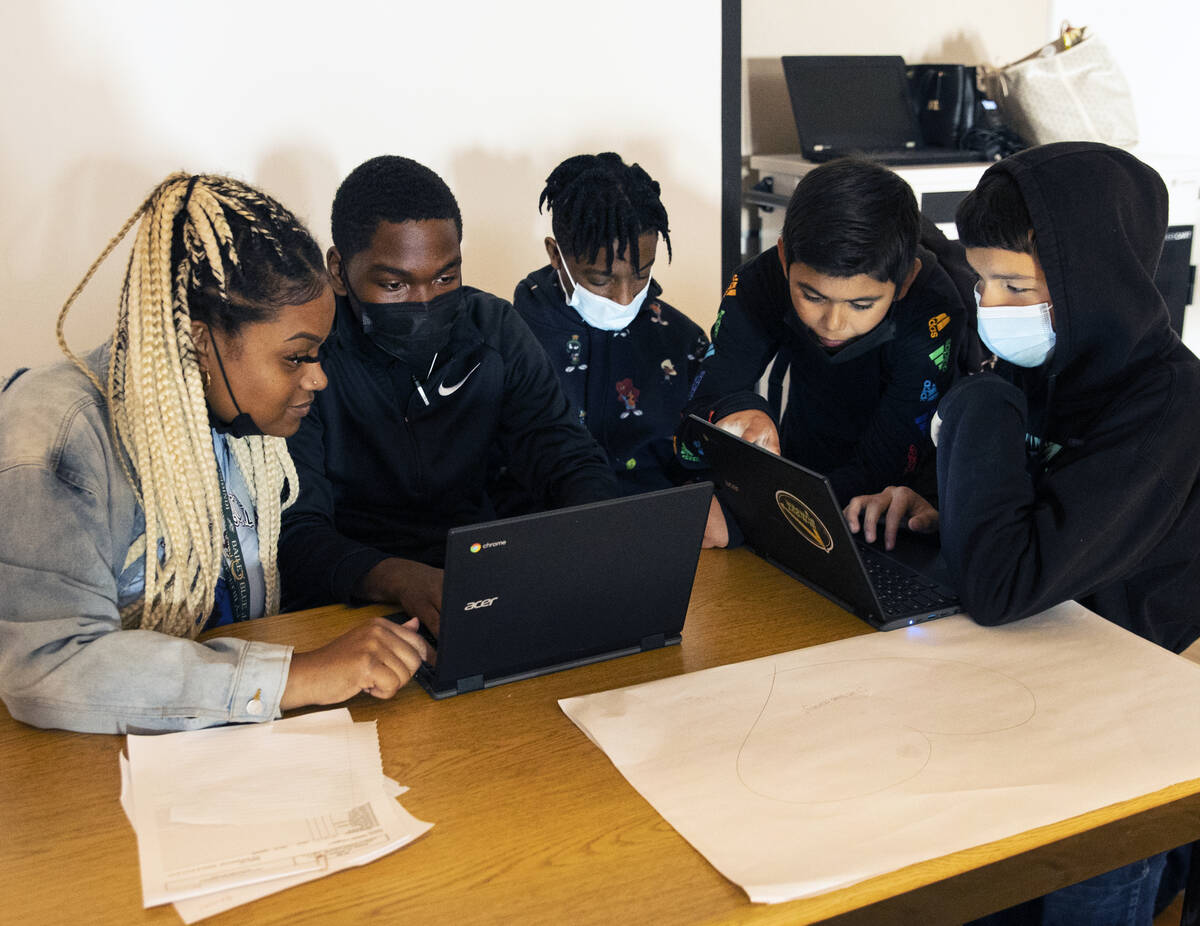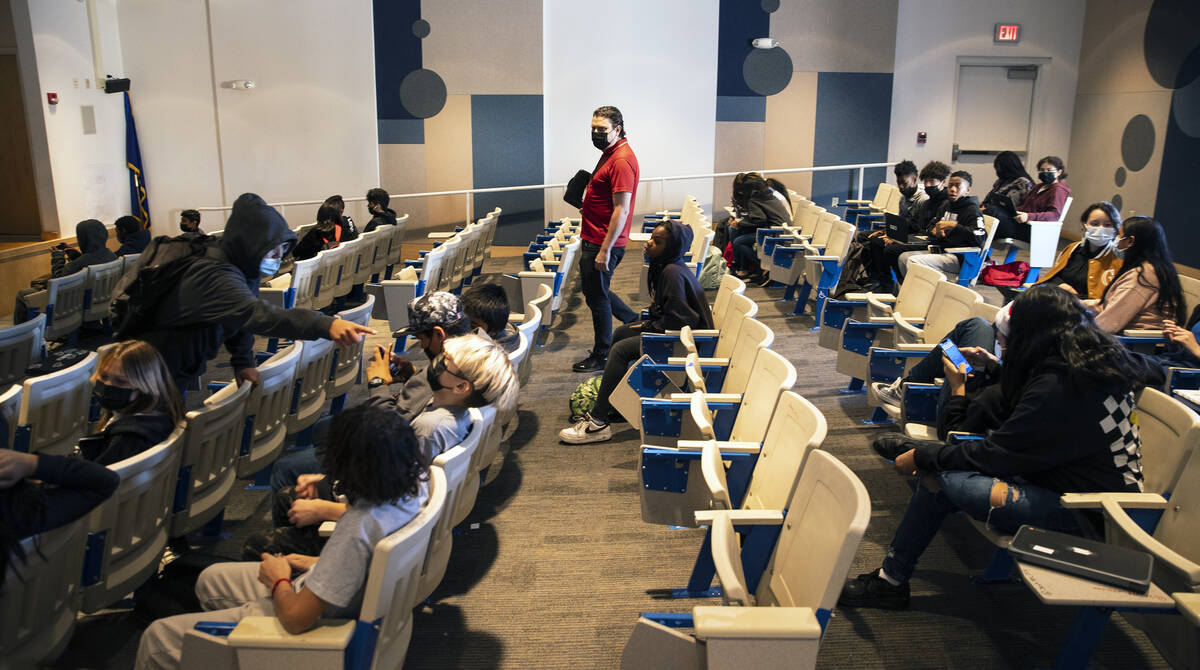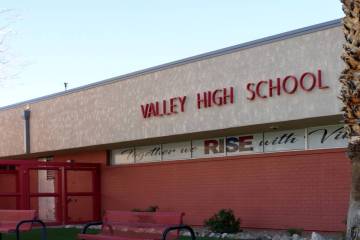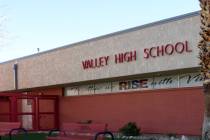‘Taking a toll’: CCSD staffing shortage getting worse, not better
The Clark County School District’s staffing shortage is growing worse, intensifying pressure on overworked staff and shortchanging students who missed out on live instruction last year, according to district data and teachers, principals and others interviewed by the Review-Journal.
The shortage of qualified employees cuts across the district, from the classroom to operations, but is not evenly felt at all schools. Where it is, employees describe long days of working in multiple roles, teaching oversize classes and trying to avoid the inevitable burnout that comes from trying to do too much with too little.
“Quite honestly, there just doesn’t seem to be any relief in sight,” said Darryl Wyatt, principal at Bailey Middle School in Las Vegas. “… It’s definitely taking a toll on everybody.”
The situation in Clark County mirrors a national problem. Some schools in other states, including in the Seattle area and Ann Arbor, Michigan, have been forced to cancel classes or switch to remote learning for at least one day this semester because of staffing issues. And Massachusetts National Guard troops were deployed to drive school buses for a couple of months because of a lack of school bus drivers in the Bay State.
It’s not clear how Clark County’s shortfall compares to those in other states, but district data indicates it is still growing worse, at least among licensed teachers.
More vacancies than at year’s start
As of Friday, the school district, which has more than 40,000 employees, had about 850 licensed employee vacancies, a spokesman said, adding that between 97 percent and 98 percent of licensed job positions are filled.
That’s up from about 700 vacancies on the first day of school in early August, an increase of more than 21 percent.
The district spokesman didn’t have support staff vacancy numbers available Friday. The school district’s job search website, though, had 731 positions listed. As of late July, there were 387 openings in the category.
The district is also facing a shortage of school bus drivers, with about 240 vacant positions as of early October. It could not provide updated numbers on Friday.
It’s not clear why the number of teaching vacancies is growing. The school district didn’t make an official involved in the district’s hiring effort available for an interview.
The School Board regularly approves new hires and employee departures as part of its consent agenda.
This month, for example, the board approved hiring one school administrator and 38 new licensed employees, all of whom had start dates listed in November.
But at the same meeting, the board also approved the “separations” of 52 licensed personnel and eight administrators. Reasons given for departure included medical issues, dismissal, other employment, dissatisfaction with the district, retirement, death, relocation and a return to school. Most of the effective dates were in November, but some dated to earlier in the school year.
Trustees also approved a support staff personnel report for Oct. 24-Nov. 6 that showed 167 new hires and 77 workers departing. The report included a category for “service/transportation workers,” which showed four new hires and 14 departures.
Concerns about working conditions
School district employees have voiced concerns for months at School Board meetings about overcrowded classes, a heavy workload and COVID-19 safety protocols they say are inadequate. Some educators said they resigned midyear because of such issues.
Jim Frazee, a high school teacher and vice president of the Clark County Education Association teachers union, recently told the School Board that his colleagues have repeatedly appeared before them in tears for months. The trustees nod their heads and are empathetic, he said, but nothing gets done.
“CCEA has had it,” he said forcefully.
Frazee said he wants an emergency board meeting to look at why so many educators and support staff are walking out the door.
The staff shortage manifests itself in different ways at different schools.
At Bailey Middle School, which has about 1,400 students, Wyatt said it’s typical to have eight or so teachers absent on any given day and no substitutes available to fill in.
Since school began in early August, he said, he starts each workday by looking at how many classrooms don’t have a teacher and working out a solution. That includes asking teachers to “sell their prep period” to cover a class.
The school also combines two classes — or on rarer occasions, three classes — and moves students into a large space such as the gym, theater or library. Students are overseen by just one teacher — a regular licensed educator or a substitute if one is available, he said.
Others such as administrators and counselors rotate through to help the teacher who is instructing dozens of students solo. The students are often working independently on lessons via Canvas, an online course management system.
Bailey has four long-term substitute teachers, up from one in previous years.
“On top of that, we also have three instructional aide positions that basically nobody applies for,” Wyatt said, as well as a couple vacant campus security monitor positions.
The school also lacks enough instructional aides to help students who are behind academically, he said.
The challenges don’t end when the dismissal bell rings at 3:01 p.m. Between 200 and 300 students often wait in or near the cafeteria for at least 75 minutes for school buses to arrive due to the driver shortage.
Wyatt said the culture at Bailey “is still upbeat and still positive” but noted that employees are exhausted and some have needed to take more time off than usual to recharge, which only adds to the problem.
Doing whatever it takes
Sarah Popek, principal of Tate Elementary School in northeast Las Vegas, echoed many of the points made by Wyatt.
“This has been a very challenging year,” she said, noting that children began the year with greater academic deficits than is typical for the school of about 750 students after spending last year in distance learning.
On top of that, there are days when students aren’t able to receive extra help because employees who typically fill that role are covering classroom vacancies, Popek said.
The school currently has one teaching vacancy in fifth grade, as well as a couple of support staff openings, Popek said.
With a shallow licensed teacher pool and lack of available substitutes, school administrators decided to split up the fifth-grade class. That meant giving each of the other fifth grade teachers about five more students.
That undercuts the school’s use of federal Title I money — as it has a large percentage of students living in poverty — to lower fifth-grade class sizes and provide extra academic and behavioral support, Popek said.
When school started, fifth-grade classes ranged from 22 to 25 students. Now, they’re at 25 to 29.
It’s still lower than the school district’s ratio of 33.5 to 1, Popek said, but not as low as she’d like it to be.
When teachers are absent at the school, three learning strategists, who typically work with students who are significantly below grade level academically, often fill in for day-to-day classroom vacancies, Popek said.
Sometimes, the school also splits classes, meaning a teacher takes on additional students for the day.
“I try to avoid that,” Popek said, because it puts more strain on teachers and it’s difficult for students. It also makes COVID-19 contract tracing more difficult when a case is confirmed at the school.
The school’s head custodian also has been working overtime, and there have been nights when Popek removed trash from classrooms.
School cleanliness is more critical now than ever for student and employee safety, Popek said. “You can’t really skimp on custodial duties.”
At Spring Valley High School, Principal Tara Powell takes on tasks on a daily basis that aren’t in her job description.
“Every day we’re doing something that’s not normal,” she said.
That even includes donning a hair net and working in the cafeteria, when needed.
“I like serving lunch, so that’s alright,” Powell said.
Employees are doing whatever it takes to keep the school running, Powell said, but she knows they’re tired. “The staff has been given a heavy load, but they’ve risen to the occasion.”
The number of employee vacancies has fluctuated this school year, but there are more than pre-pandemic years. Some teachers have sold their prep periods to teach more classes, and school administrators and strategists are helping in classrooms, Powell said.
Pre-pandemic, there were usually one or two long-term substitutes. This school year, there are typically several.
The school also has more vacancies for support staff than normal, Powell said, adding, “The pay is a challenge.”
There are a couple of open support professional jobs in special education classrooms, as well as for custodians, who are working overtime and comp time.
To try to address the staffing shortage, Spring Valley High administrators are using their contacts and interviewing job candidates quickly when they appear in a computer management system.
“We’re trying to be proactive,” Powell said. “We’re trying to be ahead of it.”
There has been some recent success with hiring teachers who’ve recently moved in from out of state, Powell said, noting she hired an autism teacher from Hawaii more than six weeks ago.
The school also has a couple of UNLV alternate route to licensure teacher candidates as long-term substitutes this fall — one in social studies and one in math. Those are aspiring teachers who have a bachelor’s degree in a field other than education who want to earn a teaching credential.
Now, she’s in the process of hiring both of them under provisional state teaching licenses since they’re wrapping up their coursework this month.
Powell is also hiring a third alternate route to licensure candidate who’ll take over Spanish 1 classes in mid-January.
Selling prep periods
At Rancho High School in Las Vegas, social studies teacher Robert Cowles sold both of his prep periods this school year and is teaching eight classes because of staffing shortages.
“Not having a prep during the school day means I have to do all the things I’d do on my prep outside of my contract day,” Cowles said.
He also hasn’t been able to participate in professional learning communities with colleagues who teach the same subjects.
“My colleagues have been great about sharing what they’re doing, but the interaction/discussion with them is lost,” he said.
Cowles said he knew, or thought he knew, what he was getting into. He sold his prep periods in past years at schools without block schedules, but those campuses had more before and after school contract time where he could meet with colleagues.
Cowles is teaching four classes — two sections of U.S. history, one section of world history, two sections of Advanced Placement human geography and three sections of AP U.S. history.
Five other social studies teachers at his school sold a prep period to take on an additional class, he said, to make up for a couple of vacancies in his department.
“A few others in my department also routinely cover classes when there’s a teacher out without a substitute teacher,” he said. “That happens almost daily.”
Problem varies across district
Not all CCSD schools are feeling the same impact.
Derek Fialkiewicz, principal at Lied STEM Academy, a middle school in Las Vegas, said in late November that the school hasn’t experienced staffing issues.
At Liberty High School in west Henderson, Principal Derek Bellow said he’s also good on teacher staffing.
The school has a couple of open support staff positions for special education aides and custodian, but nothing that’s causing a major issue here.”
Bellow said he can’t speculate why Liberty High, which has more than 3,300 students and was more than 100 students over enrollment projections this fall, isn’t facing the same degree of a staffing shortage as other campuses.
A lot of people in the education profession — including teachers, administrators and support staff — have decided to retire, resign or look for employment elsewhere during the COVID-19 pandemic, Bellow said.
At Liberty High, “We’re fortunate that we didn’t have that,” he said, adding that it was the “luck of the draw.”
Some teachers, though, have sold their prep periods in order to keep class sizes down or cover classes on a day-to-day basis when there aren’t substitute teachers available. And sometimes, school administrators cover classes.
The lack of substitute teachers is “dramatically different” now than it used to be, Bellow said. “Obviously, I don’t think that’s going to come as a great surprise to anybody.”
Overall, Bellow said he believes school leaders throughout Clark County have done a remarkable job keeping schools open. But he said the COVID-19 pandemic has driven home the importance of school employees in delivering a quality education, a lesson that’s being taught around the country.
“We just don’t invest (or) put enough value in paying these individuals a competitive wage or earning with what they’re commanded to do,” he said.
Contact Julie Wootton-Greener at jgreener@reviewjournal.com or 702-387-2921. Follow @julieswootton on Twitter.


























